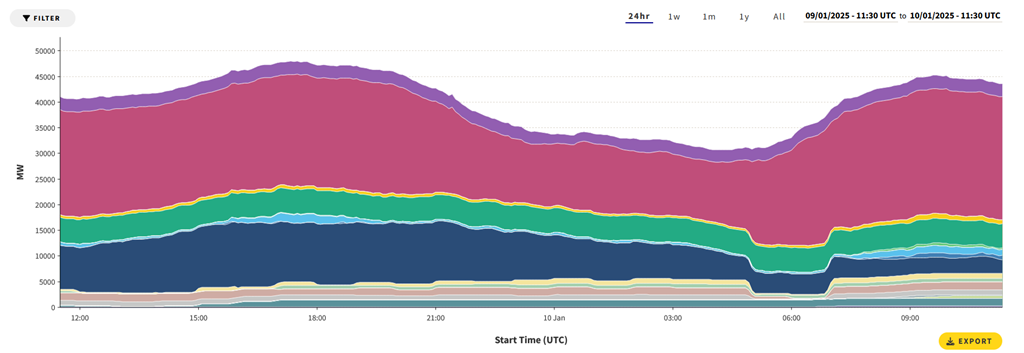Decreased vertical exchange in cold surface currents and in upwelling zones increases thermal stratification and slows down the Atlantic Meridional Overturning Circulation (AMOC), retains heat longer in the surface ocean, and reduces CO₂ exchange among the atmosphere, surface ocean, and the deep sea. The HotSpot maps from year to year suggest that upwelling systems can abruptly shut off, causing sudden sharp rises in regional air temperatures, and reducing air-ocean exchange of temperature and CO₂.
Polar amplification of the temperature rise causes a relative slowing down of the speed at which heat flows from the Equator to the poles. This impacts ocean currents and wind patterns, resulting in slowing down of the Atlantic meridional overturning circulation (AMOC) and of ocean currents around Antarctica that carry heat to the deep ocean, as well as in deformation of the Jet Stream.
warns about intensification of global warming due to the slowdown of the overturning circulation. The overturning circulation carries carbon dioxide and heat to the deep ocean, where it is stored and hidden from the atmosphere. As the ocean storage capacity is reduced, more carbon dioxide and heat are left in the atmosphere. This feedback accelerates global warming.
8. Further mechanisms
8.1. El Niño and sunspots
forecast.
that the IRI plume predicts a weak and a short duration La Niña, as indicated by the Niño-3.4 index values less than -0.5°C.
 |
| [ IRI ENSO forecast from Oct 2024 ] |
 |
| [ click on images to enlarge ] |
The above image, adapted from NOAA, illustrates that El Niño conditions were present from June 2023 through April 2024, and that ENSO-neutral conditions were present from May 2024 through September 2024.
8.2. Earth’s Energy Imbalance and lack of political will to act
Earth’s growing energy imbalance is perhaps the most obvious mechanism that increases the temperature.


The IPCC has for many years weaved and twisted findings by scientists into a political narrative that downplays the temperature rise and refuses to point at the most effective measures to be taken to act on climate change, in an effort to create the illusion that there was a carbon budget to be divided among polluters as if pollution could continue for decades to come.
Lack of political will to act on the climate emergency is perhaps the most depressing mechanism accelerating the temperature rise. Moreover, where action is taken, blunt political instruments are all too often chosen that won’t last long or turn out to be counter-productive.
8.3. Aerosols
Sadly, few people are calling for more sophisticated measures, let alone for more effective measures such as local feebates. It is important to be open and clear as to what can and must be achieved and how, and why.
Scientist warn that the combined impact of aerosols and nitrogen fertilizers has been underestimated; a recent study concludes that when ammonia, nitric acid and sulfuric acid are present together, they contribute strongly to the formation of cirrus clouds.
The IPCC image below shows how much temperatures are currently suppressed in the Arctic due to aerosols and thus also shows how much temperatures in the Arctic look set to rise as the aerosol masking effect falls away.

8.4. Water vapor and the importance of the size of the temperature rise

The image below, adapted from Climate Reanalyzer, shows the spread of the September 2024 anomaly in precipitable water, with less over the Amazon, but more over the Sahara, while more also shows up at higher northern latitudes, i.e. over the Barents Sea and the Canadian Arctic Archipelago.


A lot of the extra water vapor gets into the atmosphere through evaporation from oceans, but a significant part also comes from land and water bodies on land. A lot of energy gets consumed in the process of evaporation from land and lakes and in the process of thawing of permafrost. Water that previously remained present in the ground, is increasingly moving up into the atmosphere. The water vapor feedback results in more moisture getting sucked up into the air as temperatures rise, a process that can be further accelerated by stronger wind as temperatures rise.
The image illustrates the danger of the Land Evaporation Tipping Point getting crossed locally when water is no longer available locally for further evapotranspiration, i.e. from all processes by which water moves from the land surface to the atmosphere via evaporation and transpiration, including transpiration from vegetation, evaporation from the soil surface, from the capillary fringe of the groundwater table, and from water bodies on land. Once this tipping point gets crossed, the land and atmosphere will heat up strongly, due to the extra heat, i.e. heat that was previously consumed by evaporation and thawing. Additionally, more water vapor in the atmosphere accelerates the temperature rise, since water vapor is a potent greenhouse gas and this also contributes to speeding up the temperature rise of the atmosphere.
Similarly, the rise to come (over the next few years) could be significantly larger than expected, e.g. due to the above seven mechanisms relating to changes in snow & ice, winds and oceans, in which case the extra water vapor will accordingly be larger.
The image below shows the global September 2024 sea surface temperature anomaly (versus 1951-1980, ERA5 data, adapted from Climate Reanalyzer).

The image below shows that the September 2024 sea surface temperature anomaly (versus 1951-1980) was at a record high, in a tie with October 2023, in the area between latitudes 10°North and 40°North.

8.5. Tipping points
Loss of Arctic sea ice and loss of Permafrost in Siberia and North America can be regarded both as feedbacks and as tipping points. Loss of Antarctic sea ice and loss of the snow and ice cover on land elsewhere (on Greenland, on Antarctica and on mountaintops such as the Tibetan Plateau) can also be regarded as tipping points.
What makes them tipping points is that, once the snow and ice cover has disappeared and the ice in the soil has melted, further heat can no longer be consumed in the process of melting or thawing, resulting in a sudden local temperature rise that spreads to neighboring areas.
The image below lists 14 events. Note that the 14 mechanisms below are from an earlier post and many mechanisms differ from the above 8 mechanisms. Note also that the order may differ and that, instead of one domino tipping over the next one sequentially, many events may occur simultaneously and reinforce each other in the speed at which they unfold and the temperature rise that results. There could be interaction and amplification between mechanisms, resulting in a huge abrupt acceleration of the temperature rise that leads to extinction of most species, including humans, as the image below warns, from an earlier post. Finally, note that there could be Black Swan Events that have not yet been identified.
– The Seafloor Methane Tipping Point (feedback #16)
– The Clouds Tipping Point (also clouds feedback #30)
– The Terrestrial Biosphere Temperature Tipping Point
– The Ocean Surface Tipping Point (also discussed at facebook)
– The Land Evaporation Tipping Point (discussed above, also discussed at facebook)
– The Aquatic Deoxygenation Tipping Point (also discussed at facebook)
A huge temperature rise could occur soon, as the impact of these mechanisms keeps growing, as the latent heat tipping point gets crossed in a Double Blue Ocean Event and the seafloor methane tipping point subsequently gets crossed.
As temperatures keep rising in the Arctic, changes to the Jet Stream look set to intensify, resulting in loss of terrestrial albedo in the Arctic that could equal the albedo loss resulting from sea ice decline.
Further feedbacks include permafrost degradation, both terrestrial and on the seafloor of the Arctic Ocean, which looks set to cause huge releases of greenhouse gases (particularly CO₂, CH₄ and N₂O).
This would in turn also cause more water vapor to enter the atmosphere, further speeding up the temperature rise.
The danger of a huge temperature rise is very large in the Arctic, where vast amounts of methane are held in sediments at the seafloor and in permafrost on land, and where there is very little hydroxyl in the air to break down the methane.







Leave a Comment